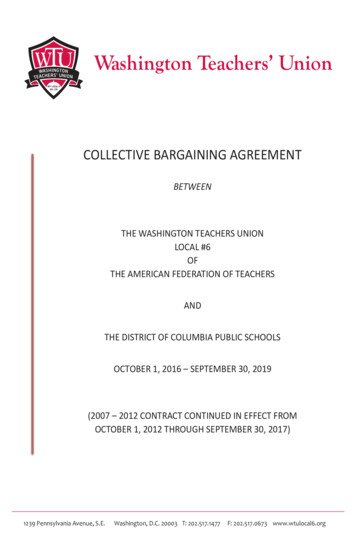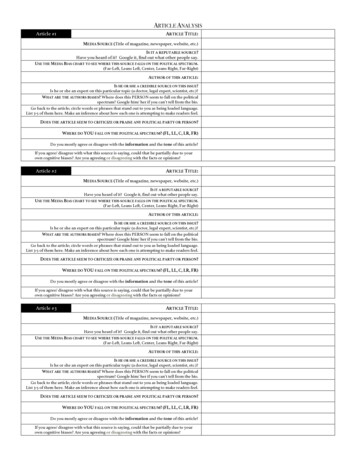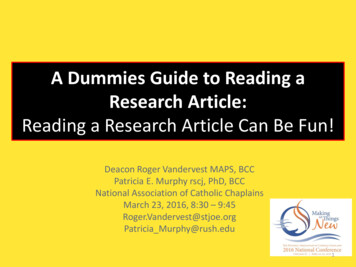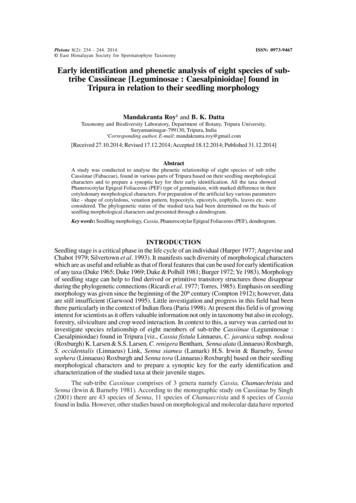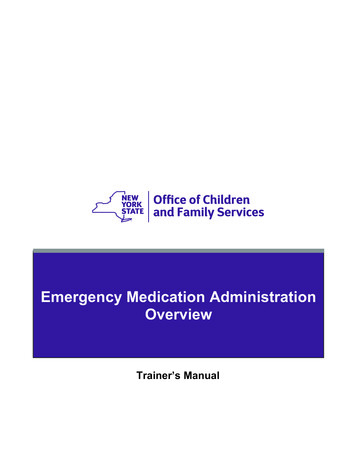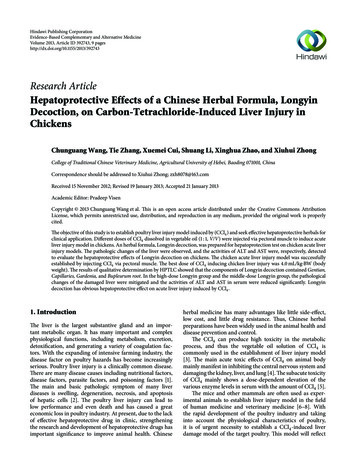
Transcription
Hindawi Publishing CorporationEvidence-Based Complementary and Alternative MedicineVolume 2013, Article ID 392743, 9 pageshttp://dx.doi.org/10.1155/2013/392743Research ArticleHepatoprotective Effects of a Chinese Herbal Formula, LongyinDecoction, on Carbon-Tetrachloride-Induced Liver Injury inChickensChunguang Wang, Tie Zhang, Xuemei Cui, Shuang Li, Xinghua Zhao, and Xiuhui ZhongCollege of Traditional Chinese Veterinary Medicine, Agricultural University of Hebei, Baoding 071001, ChinaCorrespondence should be addressed to Xiuhui Zhong; zxh8078@163.comReceived 15 November 2012; Revised 19 January 2013; Accepted 21 January 2013Academic Editor: Pradeep VisenCopyright 2013 Chunguang Wang et al. This is an open access article distributed under the Creative Commons AttributionLicense, which permits unrestricted use, distribution, and reproduction in any medium, provided the original work is properlycited.The objective of this study is to establish poultry liver injury model induced by (CCl4 ) and seek effective hepatoprotective herbals forclinical application. Different doses of CCl4 dissolved in vegetable oil (1 : 1, V/V) were injected via pectoral muscle to induce acuteliver injury model in chickens. An herbal formula, Longyin decoction, was prepared for hepatoprotection test on chicken acute liverinjury models. The pathologic changes of the liver were observed, and the activities of ALT and AST were, respectively, detectedto evaluate the hepatoprotective effects of Longyin decoction on chickens. The chicken acute liver injury model was successfullyestablished by injecting CCl4 via pectoral muscle. The best dose of CCl4 inducing chicken liver injury was 4.0 mL/kg BW (bodyweight). The results of qualitative determination by HPTLC showed that the components of Longyin decoction contained Gentian,Capillaries, Gardenia, and Bupleurum root. In the high-dose Longyin group and the middle-dose Longyin group, the pathologicalchanges of the damaged liver were mitigated and the activities of ALT and AST in serum were reduced significantly. Longyindecoction has obvious hepatoprotective effect on acute liver injury induced by CCl4 .1. IntroductionThe liver is the largest substantive gland and an important metabolic organ. It has many important and complexphysiological functions, including metabolism, excretion,detoxification, and generating a variety of coagulation factors. With the expanding of intensive farming industry, thedisease factor on poultry hazards has become increasinglyserious. Poultry liver injury is a clinically common disease.There are many disease causes including nutritional factors,disease factors, parasite factors, and poisoning factors [1].The main and basic pathologic symptom of many liverdiseases is swelling, degeneration, necrosis, and apoptosisof hepatic cells [2]. The poultry liver injury can lead tolow performance and even death and has caused a greateconomic loss in poultry industry. At present, due to the lackof effective hepatoprotective drug in clinic, strengtheningthe research and development of hepatoprotective drugs hasimportant significance to improve animal health. Chineseherbal medicine has many advantages like little side-effect,low cost, and little drug resistance. Thus, Chinese herbalpreparations have been widely used in the animal health anddisease prevention and control.The CCl4 can produce high toxicity in the metabolicprocess, and thus the vegetable oil solution of CCl4 iscommonly used in the establishment of liver injury model[3]. The main acute toxic effects of CCl4 on animal bodymainly manifest in inhibiting the central nervous system anddamaging the kidney, liver, and lung [4]. The subacute toxicityof CCl4 mainly shows a dose-dependent elevation of thevarious enzyme levels in serum with the amount of CCl4 [5].The mice and other mammals are often used as experimental animals to establish liver injury model in the fieldof human medicine and veterinary medicine [6–8]. Withthe rapid development of the poultry industry and takinginto account the physiological characteristics of poultry,it is of urgent necessity to establish a CCl4 -induced liverdamage model of the target poultry. This model will reflect
2more accurately the changes of metabolism, function, andhistological structures in poultry body.We established the chicken liver injury model inducedby CCl4 to provide basis for practical application of poultrypathology and clinical diagnosis. At the same time we alsostudied the hepatoprotective effects of Longyin decoction.The best dose of CCl4 and the possible hepatoprotectivemechanism of the herbals were investigated in order toprovide theoretical basis for research and development ofhepatoprotective herbals.2. Materials and Methods2.1. Chickens. A total of 360 ISA Brown layers at the ageof 1 d were purchased from Shijiazhuang Jinyu GrandfatherChicken Farm. They were fed for 15 d according to thefeeding standard of chicken (NY/T33-2004) promulgated bythe Ministry of Agriculture of the People’s Republic of China.Then 60 ISA Brown layers at the age of 15 d were selectedto establish liver injury model according to the standards ofhealth and body weight. The other 300 ISA Brown layers wereused for hepatoprotecting study of Chinese herbal medicine.All procedures concerning animal treatments and experimentations in this study were reviewed and approved bythe Institutional Committee for Ethical Use of ExperimentalAnimals at Hebei Provincial Department of Animal Science.2.2. Reagents. Longdan Xiegan powder was purchased fromthe Henan Shangdu Pharmaceutics Co., Ltd. This herbalproduct was used as a positive control drug, commerciallyavailable and documented in the Chinese Pharmacopoeia ofVeterinary Drugs.Reference herbs and reference herbal components werepurchased from China Institute of Veterinary Drug Control.Silica gel G thin plate was purchased from Yantai ChemicalIndustry Research Institute. Carbon tetrachloride (CCl4 ) waspurchased from the Beijing Chemical Reagent Company.The formula of Longyin decoction includes Capillaries,Gentian, Gardenia, Bupleurum root, and Licorice, where thefive herbs are of equivalent weight (200 g). They were soakedin 10 times weight of distilled water for 30 min and thenbrought to boiling. After simmered for 20 min, they werefiltered with four layers of gauze and the herbal soup wascollected. Five times weight of distilled water was added intothe remaining herbals for a second decoction for another20 min and then filtered. The herbal soup collected at twotimes was put together and concentrated on a slow fire untilthe crude herbal content is l g/mL. Finally, the preparedLongyin decoction was sterilized and stored in refrigeratorfor use.2.3. Establishment of Chicken Acute Liver Injury Model byInjecting CCl4 . A total of 60 healthy chickens were randomlydivided into six groups, including five model groups (groupsI–V) and blank control group, 10 chickens of each group.On the first and third days, the chickens were, respectively,challenged with the CCl4 peanut oil solution at the volumeratio of 1 : 1. The injection dose of the CCl4 peanut oilEvidence-Based Complementary and Alternative Medicinesolution in groups I, II, III, IV, and V were 1.0, 2.0, 4.0, 8.0,and 16.0 mL/kg BW, respectively. In the blank control group,the chickens were injected with peanut oil (4.0 mL/kg BW)via pectoral muscle. During the whole trial, the clinicalsymptoms of these chickens in each group were monitoredand recorded. On days 4 and 7, five chickens were selectedfrom each group and the blood samples were collected viawing vein, and then the serum was separated. The activitiesof the ALT and AST in serum were detected by the automaticbiochemical analyzer. The experimental data were analyzedwith SPSS 11.5 statistical software. Moreover, the pathologicalchanges of liver and other major organs were observed. Thebest dose of CCl4 was determined according to the minimumdose of CCl4 which can induce the visible necrotic lesions andcan significantly increase serum aminotransferase activity inliver.2.4. Detection of Longyin Herbal Formula by HPTLC. Fourtests for the identification of Gentian, Capillaries, Gardenia,and Bupleurum root was carried out, three sample solutions(including sample solutions 1, 2, and 3) in each test. Preparation of sample solution was as follows: 10.0 mL Longyindecoction was evaporated to dryness with water bath andthe residue was dissolved in 1.0 mL methanol. Moreover,in the preparation of sample solution for identification ofBupleurum root, the 10.0 mL Longyin decoction was firstlyextracted with n-butanol, and then it was evaporated todryness and dissolved in 1.0 mL methanol. Preparation ofcontrol drug solution was as follows: each of 1.0 g referencedrug substance (Gentian, Capillaries, or Gardenia) was boiledand filtered; the filtrate was evaporated to dryness andthen added 2.0 mL methanol. The reference drug substanceBupleurum root was firstly extracted with n-butanol, and thenit was boiled, filtered and evaporated; finally, it was dissolvedin methanol. Each of 1.0 mg gentiopicroside, geniposide,and saikosaponin-𝛼 was respectively, dissolved in 1.0 mLmethanol and they were used as control solution. The negative Longyin decoction sample free of the corresponding drugwas prepared according to the prescription. The preparationmethod of negative control solution was the same as thatof the above sample solution. Each of 2.0–2.5 𝜇L preparedsolution was used for identification of Gentian, Capillaries,Gardenia, and Bupleurum root by HPTLC method.2.5. Protection Test of Longyin Decoction on Liver. A totalof 300 chickens were randomly divided into four treatmentgroups including high-dose Longyin group, middle-doseLongyin group, low-dose Longyin group, and drug controlgroup. The two control groups include model control groupand blank control group, 50 chickens of each group. Thebest dose of CCl4 to induce liver injury was determinedaccording to the liver injury model test. Except the blankcontrol group, the chickens in other groups were injectedtwice via pectoral muscle with CCl4 peanut oil solution(4.0 mL/kg BW) on days 1 and 3. After the last injection (day3), the chickens in each group were treated with differentdrugs for 5 days consecutively (from days 4 to 8). The chickensin the low-dose Longyin group, middle-dose Longyin group,and high-dose Longyin group were treated with different
Evidence-Based Complementary and Alternative Medicine3doses of the Longyin decoction (1.0, 2.0, and 4.0 mL/L, resp.)via drinking water. Chickens in the drug control groupwere treated with Longdan Xiegan powder (2.5 g/kg) mixedwith feed. Those chickens in the model group and blankcontrol group were not treated with herbals. On the firstday after 5 days, herbal treatment (day 9), the blood sampleswere collected from the chickens in each group via wingvein, and the activities of ALT and AST in serum weredetected. After blood sampling, the livers were picked andthe lesions were observed. The liver tissues were sliced andstained with HE. The liver histological changes were observedand photographed with the OLYMPUS microscope, and theexperimental data were analyzed with SPSS 11.5 statisticalsoftware.3. Results3.1. Chicken Acute Liver Injury Model Induced by CCl4 . Inthe blank control group, the chickens kept good spirit andappetite and did not show any clinical symptoms. After firstchallenge with CCl4 , the chickens in model groups showedslightly decreased reactivity and had no other obvious clinicalsymptoms. After second challenge, most of the chickensin model groups showed listlessness and decreased feedintake. In groups III, IV, and V, some chickens dischargedyellowish green loose stools and showed standing instability and even recumbency. The appetite was recovered onday 6.Pathological changes of the liver were observed throughclinical autopsy. In group I, the liver was slightly largerand showed slightly yellow color (Figure 1). In group II, thesuperficial necrosis was found in some chicken liver edge(Figure 2). In group III, the multiple needle tip necrosisappeared in chicken liver, the cecal tonsils had scatteredbleeding points, and a small amount of bleeding point wasobserved at injection site and on endocardium or epicardium(Figure 3). In groups IV and V, much more liver lesionswere noticed. The liver was significantly larger and harder,and showed large necrotic plaque. The liver edge was bluntthick and khaki. Moreover, the splenomegaly was larger andappeared piebald (Figures 4 and 5). In the blank controlgroup, the liver was dark red, shiny, wet, flexible, and keptnormal size (Figure 6).The activities of ALT and AST in serum were detected.The results showed that the activities of ALT and AST inserum were increased with the increased dose of CCl4 . Thechanges of ALT were earlier and greater than that of AST.After challenge, both ALT activity on day 4 and AST activityon day 7 had extremely significant difference between groupIII and blank control group (𝑃 .01). These indicatedthat injecting CCl4 peanut oil solution (4.0 mL/kg BW) viapectoral muscle could cause increasing of ALT and ASTactivities in serum.According to the observation results of clinical symptoms, clinical autopsy, and aminotransferase activity detection, the best dose of CCl4 peanut oil solution inducing chicken acute liver injury was determined and was4.0 mL/kg BW (Table 1).Figure 1: Chicken liver in group I. The liver is slightly larger andyellow in color.Figure 2: Chicken liver in group II. The superficial necrosis is foundin liver edge.3.2. Qualitative Determination of Longyin Decoction. In chromatogram of sample solution, the same color spots wereshowed in corresponding position with that of control drugsolution and control solution. In chromatogram of negativesolution, there was no spot found in corresponding position(Figures 7, 8, 9, and 10).3.3. Protection Test of Chinese Herbal Medicine on ChickenAcute Liver Injury. The activities of ALT and AST in eachtreatment group were lower than that in the model controlgroup with extremely significant differences (𝑃 .01)(Table 2). The activity of ALT in serum had no significantdifference between high-dose Longyin group, middle-doseLongyin group, and blank control group (𝑃 .05). TheALT levels in middle-dose Longyin group and low-doseLongyin group were significantly different from that in drugcontrol group (𝑃 .05). In the low-dose Longyin group and
4Evidence-Based Complementary and Alternative MedicineTable 1: Detection of serum biochemical indicators after modeling test.GroupsGroup IGroup IIGroup IIIGroup IVGroup VBland control groupALT (U/L)On day 42.21 0.322.30 0.423.22 0.35 3.54 0.40 3.88 0.34 2.11 0.25AST (U/L)On day 72.41 0.422.55 0.54 3.75 0.40 4.22 0.33 4.83 0.57 2.12 0.35On day 4207.64 46.74214.91 41.09232.41 32.46248.08 53.62 265.22 39.74 198.55 33.62On day 7217.65 37.84233.66 45.54 264.07 31.29 284.64 35.06 298.07 42.70 194.39 25.16Values are mean SE, 𝑛 5. means significant difference (𝑃 0.05); Means extremely significant difference (𝑃 0.01).Figure 3: Chicken liver in group III. The multiple needle tip necrosisappears in liver.Figure 4: Chicken liver in group IV. The liver is larger and harderand shows large necrotic plaque.Table 2: Detection of serum biochemical indicators after treatmentby Longyin decoction.At necropsy the color and volume of liver in blankcontrol group were normal. In the model control group, theliver showed multiple needle tip necrosis. In the high-doseLongyin group, a few chickens showed slightly yellow at edgeof liver. In the middle-dose Longyin group, low-dose Longyingroup, and the drug control group, a small amount of needletip necrosis appeared in chicken livers.The liver histopathology of chickens in each group wasexamined. In the blank control group, the hepatic lobulescentered around the central vein, the hepatocyte tubes beingsurrounded by liver cells, showed radially walk to the lobuleedge. There was a small amount of red blood cells and whiteblood cells in the liver sinusoids between the hepatocytetubes. The liver cells were cube with plump cytoplasm andnormal structure, and the nucleus was in regular shape andlocated in the center of the cell (Figure 11).In the model control group, the hepatocyte tubes werearranged haphazardly with severe congestion and inflammatory cell infiltration. Liver cells had irregular contour withmany vacuoles formed by fatty degeneration. Some areasof liver showed necrosis, cell rupture, nuclear condensation,fragmentation, and aggregation (Figure 12).In the high-dose Longyin group, the hepatic lobuleshad clear structure, the hepatocyte tubes were arrangedGroupsALT (U/L)Low-dose Longyin group2.67 0.53BCbMiddle-dose Longyin group 2.42 0.59BCDcHigh-dose Longyin group2.37 0.67CDcDrug control group2.69 0.76BbModel control group3.83 0.46AaBlank control group2.19 0.58DcAST (U/L)239.48 47.96Bb221.24 50.62BCcd216.76 49.01Cd237.81 38.32BCbc273.50 36.65Aa192.40 30.92DeValues are mean SE, 𝑛 50.Different lowercase letters mean significant difference (𝑃 0.05); differentmajuscule letters mean extremely significant difference (𝑃 0.01).drug control group, the ALT levels have extremely significantdifferences from that in blank control group (𝑃 .01).The activity of AST in serum in each treatment groupwas significantly different from that in blank control group(𝑃 .01). There was no significant difference of AST levelsbetween high-dose Longyin group and middle-dose Longyingroup (𝑃 .05). The AST level of middle-dose Longyin groupwas significantly different from that of low-dose Longyingroup (𝑃 .05).
Evidence-Based Complementary and Alternative Medicine5Figure 5: Chicken liver in group V. The liver is larger and harderand shows large necrotic plaque.Figure 7: Thin-layer chromatogram of Gentian in Longyin decoction. 1: negative control solution free Gnetian; 2: control solution ofgentiopicroside; 3: reference drug substance of Gentian; 4–6: samplesolutions 1, 2, and 3.Figure 6: Chicken liver in blank control group. The liver is red,shiny, wet, flexible, and keeping normal volume.orderly and closely, and the liver sinusoids showed the mildcongestion (Figure 13). In the middle-dose Longyin group,the hepatic lobule structure was normal, the hepatocyte tubesarranged orderly but slightly loose with mild congestion,and the cytoplasm was reduced (Figure 14). In the low-doseLongyin group, the the hepatocyte tubes were arranged indisorder with congestion and inflammatory cell infiltration,and the liver cells showed pale watery cytoplasm (Figure 15).In the drug control group, the grade of liver lesions wasclose to those in the low-dose Longyin group, we also foundthe congestion and inflammatory cell infiltration, as well asgranular degeneration of the liver cells (Figure 16).4. Discussion4.1. Damage Effects of CCl4 on Liver. CCl4 is a strong prolivertoxicant and can produce lively trichloromethyl radicals andFigure 8: Thin-layer chromatogram of Capillaries in Longyindecoction. 1: negative control solution free Capillaries; 2: referencedrug substance of Capillaries; 3–5: sample solution 1, 2, and 3.chlorine-free radicals after getting into body via differentpathways. It can cause the lipid peroxidation of endoplasmicreticulum membrane and cell membrane, and then damage the liver cell. In addition, the CCl4 can reduce thedegeneration, necrosis, fibrosis, and canceration of liver [9].Therefore, we can observe the inflammatory cell infiltration,fatty degeneration, cloudy swelling, ballooning degeneration,and liver necrosis in liver slices. The destruction of livercell membrane structure and functional integrity causes theincrease of the soluble enzymes (ALT and AST) activity. Then
6Evidence-Based Complementary and Alternative MedicineFigure 11: HE staining of chicken liver slice in blank control group.The hepatic lobule has complete structure and the liver cell hasregular shape, 400x.Figure 9: Thin-layer chromatogram of Gardenia in Longyin decoction. 1: negative control solution free Gardenia; 2: Control solutionof geniposide; 3: reference drug substance of Gardenia; 4–6: samplesolution 1, 2, and 3.Figure 12: HE staining of chicken liver slice in model control group.The hepatocyte tubes arranged haphazardly with severe congestionand inflammatory cell infiltration, liver cells appear necrosis withnuclear fragmentation, 400x.Figure 10: Thin-layer chromatogram of Bupleurum root in Longyindecoction. 1: negative control solution free Bupleurum root; 2:control solution of saikosaponin-𝛼; 3: reference drug substance ofBupleurum root; 4–6: sample solution 1, 2, and 3.these soluble enzymes get into blood from the liver cells thus,causing the increase of serum enzyme activity. Therefore, theactivities of ALT and AST in serum are a sensitive index ofliver damage and can reflect the degree of liver damage andnecrosis to a certain extent [10].In this study, injecting CCl4 oil solution ( 4.0 mL/kg BW)via pectoral muscle can result in chicken liver substantialnecrotic lesions and great increases of ALT and AST levelsin serum. In early period of trial, the change speed of ALT isgreater than that of AST. However, we had verified that thedamage of CCl4 on chicken liver shows a toxic cumulativeeffect, namely, the chicken liver injury and increase of serumtransaminase levels induced by CCl4 require certain durationof action and a higher challenge dose. It indicates that chickenhas certain tolerability to CCl4 oil solution.4.2. Protection Effects of Longyin decoction on Liver. According to the concept of traditional Chinese Veterinarymedicine, liver damage is of 𝑄𝑖 stagnation pattern. Thepathogenesis is damp-heat stagnation resulting in liver 𝑄𝑖difficulties in moving, and the treatment principle should beto dispel damp-heat and smooth the liver [11]. A large number of clinical practices and experimental researches haveconfirmed that the Chinese herbal medicine has significantprotective effects on liver injury and has unique advantageson removing jaundice and liver protection therapy. Thetreatment of Chinese herbal medicine on liver injury ismainly manifested in the inhibition of lipid peroxidation,stabilization of biological membrane, improving hepatic
Evidence-Based Complementary and Alternative MedicineFigure 13: HE staining of chicken liver slice in high-dose Longyingroup. The hepatic lobules have clear structure, the hepatocyte tubesarranged orderly and closely, 400x.Figure 14: HE staining of chicken liver slice in middle-dose Longyingroup. The hepatocyte tubes arranged orderly but slightly loose withmild congestion, the cytoplasm is reduced, 400x.microcirculation, inhibiting liver cell apoptosis, and inflammatory cytokines [12]. Previous studies have reported manysingle Chinese herbs with hepatoprotective effects as wellas their active ingredients, including Scutellaria, Astragalus,Herba Rhodiola, Polygonum cuspidatum, Radix lithospermi,Angelica sinensis, Radix salviae miltiorrhizae, Cordycepspolysaccharide, Polysaccharide of Grifola Frondosa (PGF),Geranium flavonoids, Rhizoma Anemarrhenae total flavone,Momordica glycoside, tetramethylpyrazine (TMP), Fly thistleelement, schizandrin, tetrandrine glycyrrhizin, and others[1, 13–20]. Luo et al. have verified that the skullcap andbaicalin have protective effects on rat primary hepatocytesdamaged by ethanol. Particularly, the optimal concentrationin vitro of the baicalin is 0.05 𝜇g/mL [13]. The PGF can inhibitthe liver cell apoptosis by regulating expression of apoptosisrelated protein Bcl-2 and Bax. It also can reduce the activity ofserum transaminase, increase the SOD content and decreasethe MDA content to enhance the ability of scavenging freeradicals [1].In addition, a great number of studies have demonstrated that the protective effect of compound Chinese herbalmedicine on liver is more comprehensive. The commonly7Figure 15: HE staining of chicken liver slice in low-dose Longyingroup. The hepatocyte tubes arranged in disorder with congestionand inflammatory cell infiltration, and the liver cells show palewatery cytoplasm, 400x.Figure 16: HE staining of chicken liver slice in drug control group.The liver shows congestion and inflammatory cell infiltration, andthe liver cell shows granular degeneration, 400x.used Chinese herbal prescription includes the modifiedXiaochaihu Decoction, Longdan Xiegan powder, compoundCaiyu decoction, Peony and Licorice decoction, Yinchenhaodecoction, Glycyrrhizae decoction for purging stomach fire,and Sini decoction [21–27].The Longdan Xiegan decoction can decrease the serumlactate dehydrogenase (LDH) and ALT levels of mice withliver injury and reduce the cell degeneration and liver necrosis induced by CCl4 [22]. The compound Caiyu decoction caneffectively prevent the immunologic damage of mouse liverinduced by BCG lipopolysaccharide (LPS) and significantlydecrease the AST and ALT levels in serum [23].Many previous researches on hepatoprotective effect oftraditional Chinese medicine focus on mammalian (mouseand rat), and research subjects which focuses on poultry hasnot been reported.The Longyin decoction was modified and preparedaccording to the classic prescription of traditional Chinesemedicine “Oriental wormwood Decoction” in Waitai miyaowritten by Wang Tao of Tang Dynasty. And it includes Capillaries, Gentian, Gardenia, Bupleurum root, and Licorice [28].
8Gentian which refers to the root and rhizome of Gentianamanshurica Kitag.; Gentiana scabra Bge.; Gentiana trifloraPall., or Gentiana rigescens Franch. ex Hemsl. Capillarieswas whole herb or aboveground parts of Artemisia scopariaWaldst. et Kit. or Artemisia capillaris Thumb. Gardenia is thedried ripe fruit of Gardenia jasminoides Elli. Bupleurum rootis the dried root of Bupleurum chinense DC. or Bupleurumscorzonerifolium Willd. Licorice refers to the dried root andrhizome of Glycyrrhiza uralensis Fisch.; Glycyrrhiza inflateBat. or Glycyrrhiza glabra L. Long dan (Gentian), and Yinchen (Capillaries) functions to treat jaundice according tothe Chinese herbal book, while Zhi zi (Gardenia), chai hu(Bupleurum root), and gancao (Licorice) work together toassist Long dan and Yin chen. Take the first words of the twomain herbs, hence the formula name is Longyin decoction.In the hepatoprotective test of Longyin decoction on liver,the serum transaminase activity and the liver microstructurein each experimental group were detected and observed,respectively. The results showed that the Longyin oral liquidcould reduce liver necrosis and decrease serum transaminaseactivity (ALT and AST) and had protective effects on liverinjury induced by CCl4 .AcknowledgmentsThis study was financially supported by the Ministry ofScience and Technology, China (project no. 2011BAD34B02)and Hebei Key Technology R&D Program Grant (project no.10220414) from Department of Science & Technology, HebeiProvince, China.References[1] Y. Z. Wang, The protective effect of polysaccharide of grifolafrondosa on carbon tetrachloride induced liver injury and itsmechanism [M.S. thesis], Shandong University, 2010.[2] C. S. Xue, Q. H. Yang, and S. J. Liu, “Protective effect ofJiangzhi Ninggan capsule on acute hepatic injury induced by Dgalactosamine in mice,” Lishizhen Medicine and Materia MedicaResearch, vol. 20, pp. 295–296, 2009.[3] X. Y. Wang, G. L. Hu, and C. Y. Zhang, “Protective effect ofBaogan Hupi liquid on acute liver injury induced by carbontetrachloride,” Chinese Journal of Traditional Veterinary Science,vol. 2, pp. 10–11, 2006.[4] R. Shulze and H. Kappus, “Lyses of erythrocytes as a resultof microtonal lipid Peroxidation induced by CCl4 or FeCl2 ,”Research Communications in Chemical Pathology and Pharmacology, vol. 27, pp. 129–137, 1980.[5] J. R. Hayes, L. W. Condie, and J. F. Borzelleca, “Acute, 14day repeated dosing, and 90-day subchronic toxicity studies ofcarbon tetrachloride in CD-1 mice,” Fundamental and AppliedToxicology, vol. 7, no. 3, pp. 454–463, 1986.[6] A. Mondal, S. K. Karan, T. Singha, D. Rajalingam, and T. K.Maity, “Evaluation of hepatoprotective effect of leaves of Cassiasophera linn,” Evidence-Based Complementary and AlternativeMedicine, vol. 2012, Article ID 436139, 5 pages, 2012.[7] L. Xu, J. Gao, Y. Wang et al., “Myrica rubra extracts protect theliver from CCl4 -induced damage,” Evidence-Based Complementary and Alternative Medicine, vol. 2011, Article ID 518302, 8pages, 2011.Evidence-Based Complementary and Alternative Medicine[8] X. Zhao, H. Jia, S. Yang et al., “Salvianolic acid B reducingportal hypertension depends onmacrophages in isolated portalperfused rat livers with chronic hepatitis,” Evidence-BasedComplementary and Alternative Medicine, vol. 2012, Article ID786365, 8 pages, 2012.[9] Z. G. Wang, Studies on extracting technology of TFG andbiological activity of Geranium wilfordii maxim [M.S. thesis],Yangzhou University, 1986.[10] J. Liu, D. J. Liu, F. F. Qiao, J. N. Ni, Y. J. Lv, and E. D. Bao,“Establishment of experimental animal model of chicken liverand kidney damages induced by carbon tetrachloride,” Journalof Nanjing Agricultural University, vol. 31, pp. 117–120, 2008.[11] D. Liu, H. F. Tang, S. Q. Zhang, Y. Di, J. Meng, and J. W.Wang, “Protective effect of concentrated tablet of Polygonumcuspidatum on liver injury in mice,” Lishizhen Medicine andMateria Medica Research, vol. 18, pp. 3034–3035, 2007.[12] R. F. Yang, Establishment of mice liver injury model induced byDMN and protective effect of Chinese medicine on liver [Doctorthesis], Guangzhou University of Chinese Medicine, 2008.[13] D. S. Luo, H. H. Zheng, and Q. Liu, “Experimental research ofHuangqin elixation’s protective effect on liver injury inducedby carbon tetrachloride in rats,” Journal of Xianning MedicalCollege, vol. 15, p. 92, 2001.[14] J. T. Lu, Y. Yang, W. Wei, and Z. M. Chen, “Protective effects ofcompound astragalus extract
Four tests for the identi cation of Gentian ,Capillaries ,Gardenia , . Prepa-ration of sample solution was as follows: . mL Longyin decoction was evaporated to dryness with water bath and the residue was dissolved in .mL methanol. Moreover, in the preparation of sample solution for identi cation of . e re



